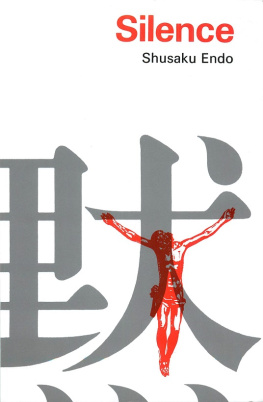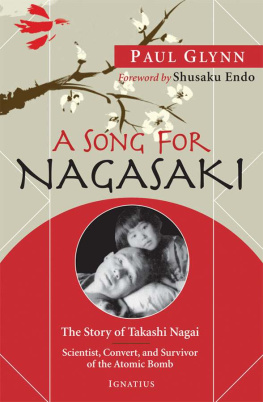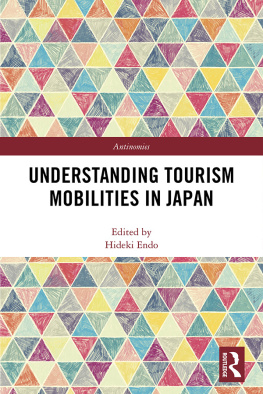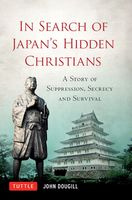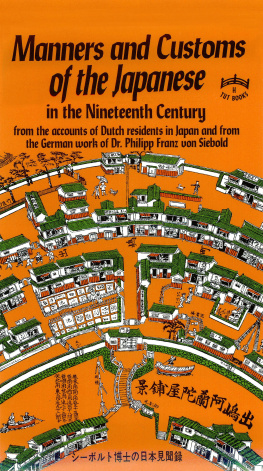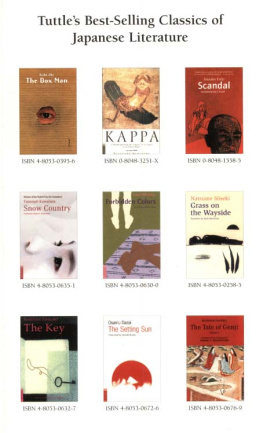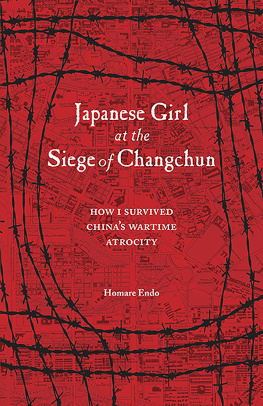Shusaku Endo - Silence
Here you can read online Shusaku Endo - Silence full text of the book (entire story) in english for free. Download pdf and epub, get meaning, cover and reviews about this ebook. year: 2014, genre: Detective and thriller. Description of the work, (preface) as well as reviews are available. Best literature library LitArk.com created for fans of good reading and offers a wide selection of genres:
Romance novel
Science fiction
Adventure
Detective
Science
History
Home and family
Prose
Art
Politics
Computer
Non-fiction
Religion
Business
Children
Humor
Choose a favorite category and find really read worthwhile books. Enjoy immersion in the world of imagination, feel the emotions of the characters or learn something new for yourself, make an fascinating discovery.
- Book:Silence
- Author:
- Genre:
- Year:2014
- Rating:5 / 5
- Favourites:Add to favourites
- Your mark:
- 100
- 1
- 2
- 3
- 4
- 5
Silence: summary, description and annotation
We offer to read an annotation, description, summary or preface (depends on what the author of the book "Silence" wrote himself). If you haven't found the necessary information about the book — write in the comments, we will try to find it.
Silence — read online for free the complete book (whole text) full work
Below is the text of the book, divided by pages. System saving the place of the last page read, allows you to conveniently read the book "Silence" online for free, without having to search again every time where you left off. Put a bookmark, and you can go to the page where you finished reading at any time.
Font size:
Interval:
Bookmark:


Silence
by S HUSAKU E NDO
Translated by William Johnston
Taplinger Publishing Company New York
Translation Copyright 1969 Monumenta Nipponica
Originally published as Chinmoku in 1966
This translation first published in 1969 by Monumenta Nipponica, Tokyo
Library of Congress Catalog Card Number 78-271168 ISBN 978-0-8008-7186-4
Table Of Contents
SHUSAKU ENDO has been called the Japanese Graham Greene. If this means that he is a Catholic novelist, that his books are problematic and controversial, that his writing is deeply psychological, that he depicts the anguish of faith and the mercy of Godthen it is certainly true. For Mr. Endo has now come to the forefront of the Japanese literary world writing about problems which at one time seemed remote from this country: problems of faith and God, of sin and betrayal, of martyrdom and apostasy.
Yet the central problem which has preoccupied Mr. Endo even from his early days is the conflict between East and West, especially in its relationship to Christianity. Assuredly this is no new problem but one which he has inherited from a long line of Japanese writers and intellectuals from the time of Meiji; but Mr. Endo is the first Catholic to put it forward with such force and to draw the clear-cut conclusion that Christianity must adapt itself radically if it is to take root in the swamp of Japan. His most recent novel, Silence, deals with the troubled period of Japanese history known as the Christian centuryabout which a word of introduction may not be out of place.
CHRISTIANITY was brought to Japan by the Basque Francis Xavier, who stepped ashore at Kagoshima in the year 1549 with two Jesuit companions and a Japanese interpreter. Within a few months of his arrival, Xavier had fallen in love with the Japanese whom he called the joy of his heart. The people whom we have met so far, he wrote enthusiastically to his companions in Goa, are the best who have as yet been discovered, and it seems to me that we shall never find another race to equal the Japanese. In spite of linguistic difficulties (We are like statues among them, he lamented) he brought some hundreds to the Christian faith before departing for China, the conversion of which seemed to him a necessary prelude to that of Japan. Yet Xavier never lost his love of the Japanese; and, in an age that tended to relegate to some kind of inferno everyone outside Christendom, it is refreshing to find him extolling the Japanese for virtues which Christian Europeans did not posses.
The real architect of the Japanese mission, however, was not Xavier but the Italian, Alessandro Valignano, who united Xaviers enthusiasm to a remarkable foresight and tenacity of purpose. By the time of his first visit to Japan in 1579 there was already a flourishing community of some 150,000 Christians, whose sterling qualities and deep faith inspired in Valignano the vision of a totally Christian island in the north of Asia. Obviously, however, such an island must quickly be purged of all excessive foreign barbarian influence; and Valignano, anxious to entrust the infant Church to a local clergy with all possible speed, set about the founding of seminaries, colleges and a novitiatepromptly despatching to Macao Francisco Cabral, who strongly opposed the plan of an indigenous Japanese Church. Soon things began to look up: daimyos in Kyushu embraced the Christian faith, bringing with them a great part of their subjects; and a thriving Japanese clergy took shape. Clearly Valignano had been building no castles in the air: his dream was that of a sober realist.
It should be noted that the missionary effort was initiated in the Sengoku Period when Japan, torn by strife among the warring daimyos, had no strong central government. The distressful situation of the country, however, was not without advantages for the missionaries who, when persecuted in one fief, could quickly shake the dust off their feet and betake themselves elsewhere. But unification was close at hand; and Japan was soon to be welded into that solid monolith which was eventually to break out over Asia in 1940. The architects of unity (Nobunaga, Hideyoshi and Ieyasu) were all on intimate terms with the Portuguese Jesuits, motivated partly by desire for trade with the black ships from Macao, partly (in the case of Nobunaga and Hideyoshi) by a deep dislike of Buddhism, and partly by the fascination of these cultured foreigners with whom they could converse without fear of betrayal and loss of prestige. Be that as it may, from 1570 until 1614 the missionaries held such a privileged position at the court of the Bakufu that their letters and reports are now the chief source of information for a period of history about which Japanese sources say little. All in all, the optimism of Valignano seemed to have ample justification.
Yet Japan can be a land of schizophrenic change; and just what prompted the xenophobic outburst of Hideyoshi has never been adequately explained. For quite suddenly, on July 24th 1587, while in his cups, he flew into a violent rage and ordered the missionaries to leave the country. I am resolved, ran his message, that the padres should not stay on Japanese soil. I therefore order that having settled their affairs within twenty days, they must return to their own country,
Nevertheless the writing was on the wall; and ten years after the first outburst, Hideyoshis anger overflowed again. This time it was occasioned by the pilot of a stranded Spanish ship who, in an effort to impress the Japanese, boasted that the greatness of the Spanish Empire was partly due to the missionaries who always prepared the way for the armed forces of the Spanish king. When this news was brought to Hideyoshi he again boiled over and ordered the immediate execution of a group of Christian missionaries. And so twenty-six, Japanese and European, were crucified on a cold winters morning in February 1597. Today, not far from Nagasaki station, there stands a monument to commemorate the spot where they died.
Yet missionary work somehow continued with the Jesuits apprehensive but still in favour at the royal court; and it was only under Hideyoshis successor Ieyasu, the first of the Tokugawas, that the death sentence of the mission became irrevocable. From the beginning, Ieyasu was none too friendly toward Christianity, though he tolerated the missionaries for the sake of the silk trade with Macao. But here things were changing: for the English and the Dutch had arrived. Nor was it long before the role of interpreter and confidant was transferred from the Portuguese Jesuits to the English Will Adamswho lost no time in assuring the Shogun that many European monarchs distrusted these meddlesome priests and expelled them from their kingdoms. Ieyasu evinced the greatest interest in the religious conflict that was rending Europe, questioning the English and the Dutch about it again and again. At the same time his apprehension grew as he observed the unquestioning obedience of his Christian subjects to their foreign guides.
And so finally in 1614 the edict of expulsion was promulgated declaring that the Kirishitan band have come to Japan longing to disseminate an evil law, to overthrow true doctrine, so that they may change the government of the country, and obtain possession of the land. This is the germ of a great disaster, and must be crushed.
Even now, however, a desperate underground missionary effort was kept alive until, under Ieyasus successors, the hunt for Christians and priests became so systematically ruthless as to wipe out every visible vestige of Christianity. Especially savage was the third Tokugawa, the neurotic Iemitsuneither the infamous brutality of the methods which he used to exterminate the Christians, nor the heroic constancy of the suffers has ever been surpassed in the long and painful history of martyrdom.
Next pageFont size:
Interval:
Bookmark:
Similar books «Silence»
Look at similar books to Silence. We have selected literature similar in name and meaning in the hope of providing readers with more options to find new, interesting, not yet read works.
Discussion, reviews of the book Silence and just readers' own opinions. Leave your comments, write what you think about the work, its meaning or the main characters. Specify what exactly you liked and what you didn't like, and why you think so.

